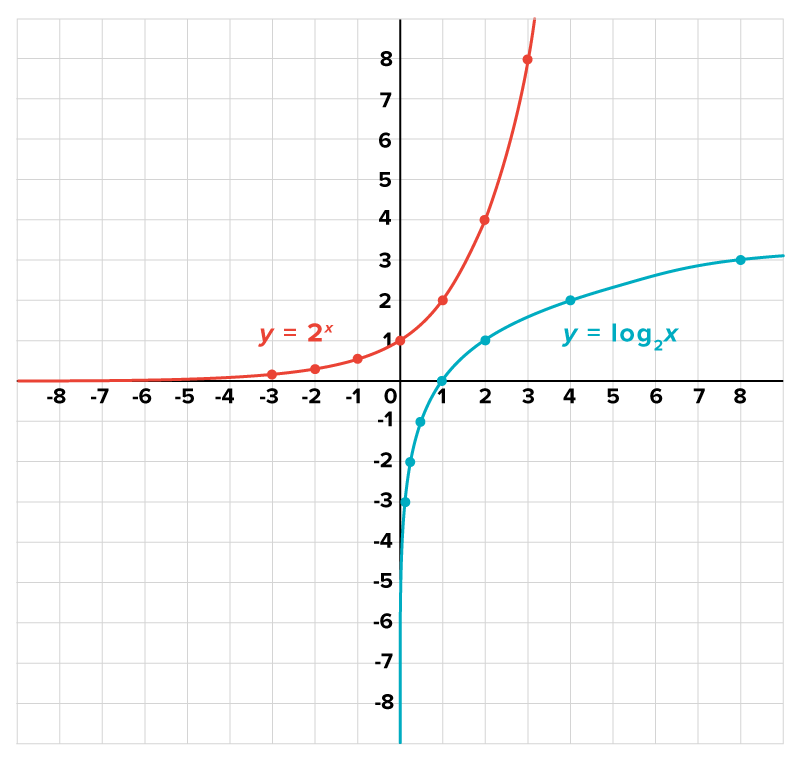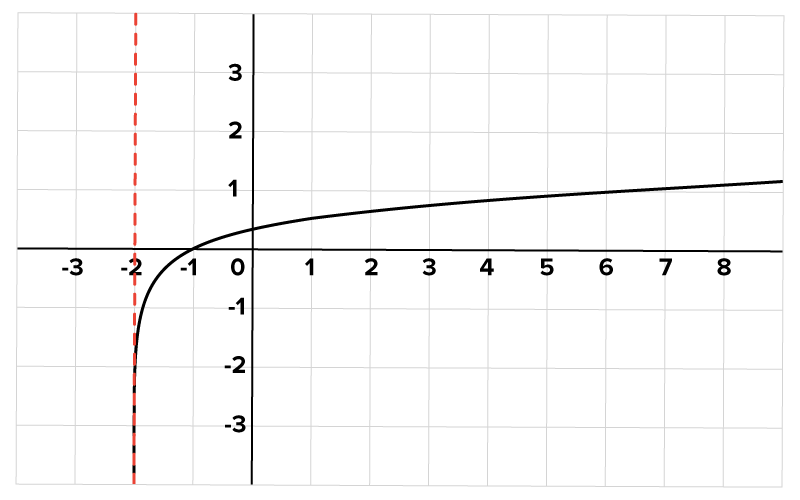Table of Contents |
Exponents and logarithms are inverse operations. This means that as functions, they are inverses of each other. There is a special relationship between inverse functions on a graph: the line  is a line of symmetry or reflection between a function and its inverse. So, we should expect this relationship to hold true when examining the graphs of an exponential function and a logarithmic function:
is a line of symmetry or reflection between a function and its inverse. So, we should expect this relationship to hold true when examining the graphs of an exponential function and a logarithmic function:
EXAMPLE
The functions and
and  are inverses. In the table below you see some key points that are on each graph.
are inverses. In the table below you see some key points that are on each graph.
| x |

|
Point | x |

|
Point | |
|---|---|---|---|---|---|---|
| -3 |

|

|

|

|

|
|
| -2 |

|

|

|

|

|
|
| -1 |

|

|

|

|

|
|
| 0 |

|

|
1 |

|

|
|
| 1 |

|

|
2 |

|

|
|
| 2 |

|

|
4 |

|

|
|
| 3 |

|

|
8 |

|

|

 This is visual evidence that they are inverses. This is what the graph of a logarithmic function looks like. We’ll get into more details in the coming material.
This is visual evidence that they are inverses. This is what the graph of a logarithmic function looks like. We’ll get into more details in the coming material.
As we can see in the graph above, since a function is symmetrical to its inverse about the line  we can interchange x- and y-values to plot points on a function's inverse. This also means that the domain and range of a function switches as we describe the domain and range of its inverse. That is, the domain of a function becomes the range of its inverse, and the range of a function becomes the domain of its inverse.
we can interchange x- and y-values to plot points on a function's inverse. This also means that the domain and range of a function switches as we describe the domain and range of its inverse. That is, the domain of a function becomes the range of its inverse, and the range of a function becomes the domain of its inverse.
Looking at the graph of the exponential function, we can see that the domain is all real x-values, written  in interval notation. This means that the range of logarithmic functions is all real y-values, written
in interval notation. This means that the range of logarithmic functions is all real y-values, written 
However, when looking at the range of the general exponential function graphed above, we see that the range is  As the x-values approach negative infinity, the y-values approach 0 but never actually touch the x-axis. Also, there are no x values that make y negative (at least in this case). So, the range of an exponential function is positive y-values written
As the x-values approach negative infinity, the y-values approach 0 but never actually touch the x-axis. Also, there are no x values that make y negative (at least in this case). So, the range of an exponential function is positive y-values written  which means the domain of the logarithmic function is restricted to positive x-values, written
which means the domain of the logarithmic function is restricted to positive x-values, written  Inputting a negative value (or zero) into the logarithmic function will yield a non-real answer.
Inputting a negative value (or zero) into the logarithmic function will yield a non-real answer.
 has domain
has domain  and range
and range 
EXAMPLE
Find the domain and range of
 If we solve this inequality, we have
If we solve this inequality, we have  Using interval notation, this is written
Using interval notation, this is written 
 written using interval notation.
written using interval notation.
 and the range is
and the range is 

Earlier, we looked at the graph of  Note that the graph passed through the point
Note that the graph passed through the point  making this the graph’s x-intercept.
making this the graph’s x-intercept.
In general, for any base b, the graph of  has its x-intercept at the point
has its x-intercept at the point  This is because
This is because  for any positive base b (except 1).
for any positive base b (except 1).
Recall that in general, the graph of  has x-intercept when
has x-intercept when  That is, we replace
That is, we replace  with 0, then solve for x.
with 0, then solve for x.
EXAMPLE
Find the x-intercept of the graph of

|
Replace y with 0. |

|
Rewrite the equation in exponential form. |

|
Simplify 
|

|
Add 4 to both sides to solve for x. |

Recall that the graph of an exponential function  has a horizontal asymptote at
has a horizontal asymptote at  meaning that the graph approaches this line in the long run (but never touches it).
meaning that the graph approaches this line in the long run (but never touches it).
Since the logarithmic function is the inverse of the exponential function, it stands to reason that the function  has a vertical asymptote at
has a vertical asymptote at 
Note that the location of the vertical asymptote corresponds to the value of x where the input of the logarithmic function is also 0.
EXAMPLE
Find the equation of the vertical asymptote of the function
 or
or  Therefore, the equation of the vertical asymptote is
Therefore, the equation of the vertical asymptote is 
 is shown below, with the vertical asymptote drawn as a dashed line.
is shown below, with the vertical asymptote drawn as a dashed line.


Notice that the graph of a logarithmic function appears to “level off” as  This is not the case though since we know that the range of a logarithmic function is all real numbers. In other words, it may appear that a logarithmic function has a horizontal asymptote, but it doesn’t.
This is not the case though since we know that the range of a logarithmic function is all real numbers. In other words, it may appear that a logarithmic function has a horizontal asymptote, but it doesn’t.
 is the graph of a logarithmic function. This is because exponential and logarithmic functions are inverses of each other. The domain of a logarithmic function is the set of all values of x for which the input to the logarithm is positive whole the range of a logarithmic function is the set of all real numbers. The x-intercept of a logarithmic function is the value of x for which the logarithm is equal to 0. The vertical asymptote of a logarithmic function is found by setting the input equal to 0, then solving for x. Even though it is visually deceiving, the graph of a logarithmic function has no horizontal asymptote.
is the graph of a logarithmic function. This is because exponential and logarithmic functions are inverses of each other. The domain of a logarithmic function is the set of all values of x for which the input to the logarithm is positive whole the range of a logarithmic function is the set of all real numbers. The x-intercept of a logarithmic function is the value of x for which the logarithm is equal to 0. The vertical asymptote of a logarithmic function is found by setting the input equal to 0, then solving for x. Even though it is visually deceiving, the graph of a logarithmic function has no horizontal asymptote.
Source: THIS TUTORIAL HAS BEEN ADAPTED FROM "BEGINNING AND INTERMEDIATE ALGEBRA" BY TYLER WALLACE. ACCESS FOR FREE AT www.wallace.ccfaculty.org/book/book.html. License: Creative Commons Attribution 3.0 Unported License